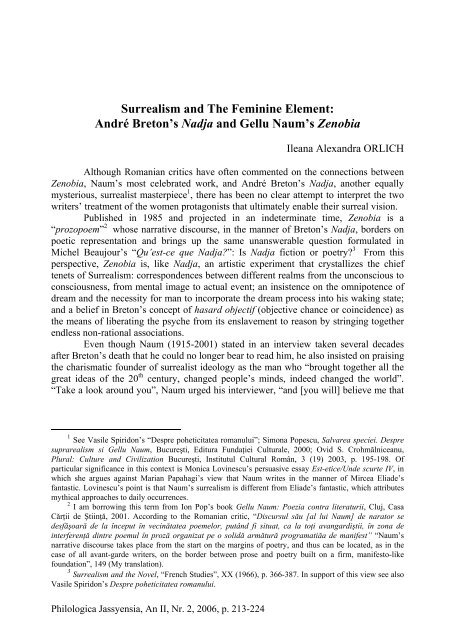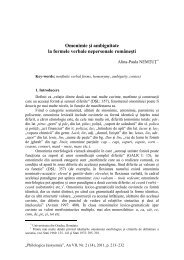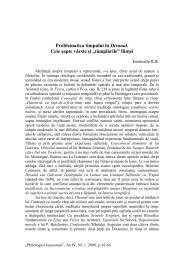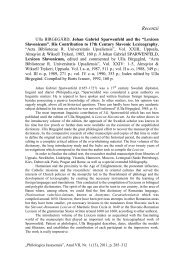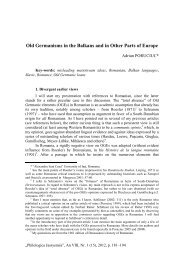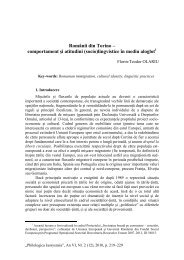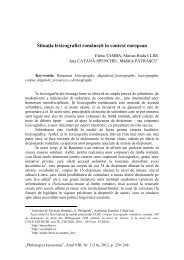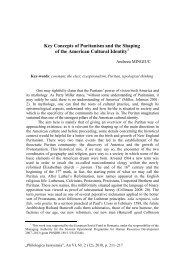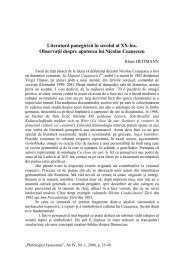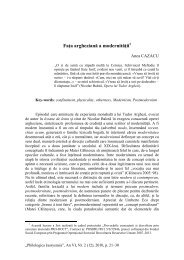Surrealism and The Feminine Element: André Breton's Nadja and ...
Surrealism and The Feminine Element: André Breton's Nadja and ...
Surrealism and The Feminine Element: André Breton's Nadja and ...
You also want an ePaper? Increase the reach of your titles
YUMPU automatically turns print PDFs into web optimized ePapers that Google loves.
<strong>Surrealism</strong> <strong>and</strong> <strong>The</strong> <strong>Feminine</strong> <strong>Element</strong>:<br />
<strong>André</strong> Breton’s <strong>Nadja</strong> <strong>and</strong> Gellu Naum’s Zenobia<br />
Philologica Jassyensia, An II, Nr. 2, 2006, p. 213-224<br />
Ileana Alex<strong>and</strong>ra ORLICH<br />
Although Romanian critics have often commented on the connections between<br />
Zenobia, Naum’s most celebrated work, <strong>and</strong> <strong>André</strong> Breton’s <strong>Nadja</strong>, another equally<br />
mysterious, surrealist masterpiece 1 , there has been no clear attempt to interpret the two<br />
writers’ treatment of the women protagonists that ultimately enable their surreal vision.<br />
Published in 1985 <strong>and</strong> projected in an indeterminate time, Zenobia is a<br />
“prozopoem” 2 whose narrative discourse, in the manner of Breton’s <strong>Nadja</strong>, borders on<br />
poetic representation <strong>and</strong> brings up the same unanswerable question formulated in<br />
Michel Beaujour’s “Qu’est-ce que <strong>Nadja</strong>?”: Is <strong>Nadja</strong> fiction or poetry? 3 From this<br />
perspective, Zenobia is, like <strong>Nadja</strong>, an artistic experiment that crystallizes the chief<br />
tenets of <strong>Surrealism</strong>: correspondences between different realms from the unconscious to<br />
consciousness, from mental image to actual event; an insistence on the omnipotence of<br />
dream <strong>and</strong> the necessity for man to incorporate the dream process into his waking state;<br />
<strong>and</strong> a belief in Breton’s concept of hasard objectif (objective chance or coincidence) as<br />
the means of liberating the psyche from its enslavement to reason by stringing together<br />
endless non-rational associations.<br />
Even though Naum (1915-2001) stated in an interview taken several decades<br />
after Breton’s death that he could no longer bear to read him, he also insisted on praising<br />
the charismatic founder of surrealist ideology as the man who “brought together all the<br />
great ideas of the 20 th century, changed people’s minds, indeed changed the world”.<br />
“Take a look around you”, Naum urged his interviewer, “<strong>and</strong> [you will] believe me that<br />
1<br />
See Vasile Spiridon’s “Despre poheticitatea romanului”; Simona Popescu, Salvarea speciei. Despre<br />
suprarealism si Gellu Naum, Bucureşti, Editura Fundaţiei Culturale, 2000; Ovid S. Crohmălniceanu,<br />
Plural: Culture <strong>and</strong> Civilization Bucureşti, Institutul Cultural Român, 3 (19) 2003, p. 195-198. Of<br />
particular significance in this context is Monica Lovinescu’s persuasive essay Est-etice/Unde scurte IV, in<br />
which she argues against Marian Papahagi’s view that Naum writes in the manner of Mircea Eliade’s<br />
fantastic. Lovinescu’s point is that Naum’s surrealism is different from Eliade’s fantastic, which attributes<br />
mythical approaches to daily occurrences.<br />
2<br />
I am borrowing this term from Ion Pop’s book Gellu Naum: Poezia contra literaturii, Cluj, Casa<br />
Cǎrţii de Ştiinţǎ, 2001. According to the Romanian critic, “Discursul său [al lui Naum] de narator se<br />
desfăşoară de la început în vecinătatea poemelor, putând fi situat, ca la toţi avangardiştii, în zona de<br />
interferenţă dintre poemul în proză organizat pe o solidă armătură programatiăa de manifest” “Naum’s<br />
narrative discourse takes place from the start on the margins of poetry, <strong>and</strong> thus can be located, as in the<br />
case of all avant-garde writers, on the border between prose <strong>and</strong> poetry built on a firm, manifesto-like<br />
foundation”, 149 (My translation).<br />
3<br />
<strong>Surrealism</strong> <strong>and</strong> the Novel, “French Studies”, XX (1966), p. 366-387. In support of this view see also<br />
Vasile Spiridon’s Despre poheticitatea romanului.
Ileana Alex<strong>and</strong>ra ORLICH<br />
_______________________________________________________________________________________________________________________________________________________________________________________________<br />
he [Breton] managed to shatter the old <strong>and</strong> false ideas – <strong>and</strong> that’s no small task” 4 .<br />
Beyond this public acknowledgement of praise for Breton, Naum was closely connected<br />
to the figures of the Romanian surrealist movement loosely clustered around a literary<br />
<strong>and</strong> artistic avant-garde that had prompted Breton’s comment that “the center of the<br />
world has moved to Bucharest.” In 1940, together with a group of surrealists that<br />
included Paul Pǎun <strong>and</strong> Virgil Teodorescu, Gellu Naum elaborated the surrealist<br />
manifesto, Critique of Misery, which defined the basic concepts of Romanian<br />
<strong>Surrealism</strong>. While borrowing some of its notes from the earlier surrealist circles centered<br />
around such reviews as “75HP”, “Contemporanul”, “Integral”, or “Unu” 5 , Naum’s<br />
manifesto also took its dictates directly from Breton, with whose work he was well<br />
acquainted from the pre-war Paris days when he was pursuing a doctoral program in<br />
philosophy <strong>and</strong> establishing the close ties with French language <strong>and</strong> literature that later<br />
made him the excellent translator into Romanian of works by Diderot, Stendhal, Victor<br />
Hugo, Alex<strong>and</strong>re Dumas, René Char <strong>and</strong> Jacques Prévert.<br />
Like Breton, Naum pleads for the quest of that “point of the mind at which,” as<br />
Breton puts it, “life <strong>and</strong> death, the real <strong>and</strong> the imagined, past <strong>and</strong> future, the<br />
communicable <strong>and</strong> the incommunicable, high <strong>and</strong> low, cease to be perceived as<br />
contradictions” 6 <strong>The</strong> very title of Naum’s first volume, <strong>The</strong> Firing Traveler (1936),<br />
announces the inc<strong>and</strong>escent itinerary of the writer’s spirit engaged in a subversive quest<br />
that continues in subsequent works, <strong>The</strong> Freedom to Sleep on a Forehead (1937), Vasco<br />
de Gama (1940), <strong>The</strong> Corridor of Sleep (1944), Medium (1945), <strong>The</strong> Terrible Forbidden<br />
(1945) <strong>and</strong> <strong>The</strong> Blind Man’s Castle (1946). Sorting <strong>and</strong> disseminating facts, Naum’s<br />
approach in all these works is to de-familiarize <strong>and</strong> excommunicate objects by giving<br />
them estranged shapes <strong>and</strong> never tested properties. Ultimately, these seemingly<br />
rambling narratives are conceived in the spirit of Benjamin Fondane’s advise in the<br />
“Preface” to his 1930 volume of poetry Privelişti, as “an autonomous universe, with<br />
arbitrary laws <strong>and</strong> unforeseen hazard. A kind of Morse code” 7 .<br />
4<br />
Interview with Simona Popescu, Suprarealism pe cont propriu, Bucureşti, Editura Fundaţiei<br />
Culturale, 2000 (my translation).<br />
5<br />
Among the prominent surrealist journals of the period, mention should be made of “75HP” which<br />
appeared in 1924 as a single issue under the directorship of Ilarie Voronca <strong>and</strong> Victor Brauner;<br />
“Contimporanul”, a leading surrealist journal, which started its publication in 1922 under the supervision of<br />
Ion Vinea <strong>and</strong> was in subsequent years responsible for organizing four surrealist exhibitions that hosted<br />
both Romanian <strong>and</strong> foreign surrealists; “Integral” (1925-1928) which started its publication in Bucharest<br />
under M.H. Maxy <strong>and</strong> later added another publishing office in Paris under Benjamin Fondane <strong>and</strong> Hans<br />
Mattis-Teutsch; “Unu” (1928-1932), led by Saşa Panǎ, which included contributions not only from<br />
prominent Romanian surrealists, such as Ilarie Voronca, Geo Bogza, Stephane Roll (the literary pseudonym<br />
of Gheorghe Dinu) but also from foreign contributors like Louis Aragon, <strong>André</strong> Breton, René Crevel, <strong>and</strong><br />
Paul Éluard, <strong>and</strong> which was richly illustrated with the art work of Marc Chagall <strong>and</strong> Man Ray, among many<br />
others.<br />
6<br />
<strong>André</strong> Breton, Second Manifesto of <strong>Surrealism</strong>, in Manifestoes of <strong>Surrealism</strong>, trans. Richard Seaver<br />
<strong>and</strong> Helen R. Lane (Ann Arbor: University of Michigan Press, 1969), p. 123-124.<br />
7<br />
Fondane’s volume, which includes poems written between 1917 <strong>and</strong> 1923, made a great impact on<br />
the newer generation of Romanian surrealists, especially through its Preface titled Câteva cuvinte pǎdureţe.<br />
Loosely translated to mean “words as tart as green apples,” this title suggests that artistic creation must not<br />
be mawkish <strong>and</strong> follow convention, but instead should use words that sting the taste buds, like tart green<br />
apples.<br />
214
<strong>Surrealism</strong> <strong>and</strong> <strong>The</strong> <strong>Feminine</strong> <strong>Element</strong>: <strong>André</strong> Breton’s <strong>Nadja</strong> <strong>and</strong> Gellu Naum’s Zenobia<br />
_______________________________________________________________________________________________________________________________________________________________________________________________<br />
As in Breton’s case, where a close reading of <strong>Nadja</strong> is necessary in order to<br />
assess the full extent of Breton’s surrealist project <strong>and</strong> the centrality of women’s role in<br />
achieving a surrealist vision, a detailed analysis of Zenobia is an obligatory step toward<br />
underst<strong>and</strong>ing it as Naum’s response <strong>and</strong> reaction to <strong>Surrealism</strong> <strong>and</strong> to Breton’s<br />
incorporation of the feminine element. And even though the discussion of <strong>Nadja</strong>’s <strong>and</strong><br />
Zenobia’s similar narrative techniques <strong>and</strong> textual poetics that I undertake is a necessary<br />
next step in this comparative study, my goal in the process is to highlight not only<br />
Naum’s recuperation of Breton’s objectives, but also the impact <strong>Surrealism</strong> <strong>and</strong> its<br />
image of woman as an essentially sensual bodily backdrop for the male vision have had<br />
in Naum’s own work. Skillfully embedded in Zenobia, such views may reveal not only<br />
Naum’s appropriations <strong>and</strong> perceived limitations <strong>and</strong> inconsistencies of Breton’s<br />
theories, but also, coming full circle, the significant contributions of Romanian modern<br />
fiction to the Surrealist experiment <strong>and</strong> to the perception of woman as a strong <strong>and</strong><br />
comm<strong>and</strong>ing presence on an imaginative plane.<br />
Originally published in 1928, Breton’s <strong>Nadja</strong> is the first <strong>and</strong> perhaps best<br />
Surrealist romance ever written. Divided into two parts, a long preamble of about<br />
seventy pages, which is a kind of illustrated essay on surrealism, <strong>and</strong> the shorter, strange<br />
story of the encounters with the character <strong>Nadja</strong>, Breton’s book identifies <strong>Surrealism</strong>’s<br />
preoccupations, principles, <strong>and</strong> attitude toward everyday life while exploring notions of<br />
love <strong>and</strong> physical passion. In recounting Breton’s love affair with <strong>Nadja</strong>, a mentally<br />
disturbed young woman in Paris, this autobiographical novel (the opening sentence is a<br />
question Qui suis-je? “Who am I?”) focuses on the writer’s own beliefs that surreal<br />
states of consciousness were best attainable through encounters with the feminine side<br />
of masculinity <strong>and</strong> sexual love.<br />
With her inability to distinguish between illusion <strong>and</strong> reality, obsessive<br />
behavior, <strong>and</strong> dark eccentricity, <strong>Nadja</strong> is “une étoile au coeur même du fini,” who<br />
synthesizes the surrealist trait of the irrational feminine forces that Breton views as<br />
complementary to the rational masculine. Although initially attracted to <strong>Nadja</strong><br />
particularly because she embodies the extralogical <strong>and</strong> extrarational modes of thought<br />
the Surrealists cherished (the first syllable of her name means “hope” in Russian),<br />
Breton ultimately ab<strong>and</strong>ons her upon discovering her growing madness; <strong>Nadja</strong>’s<br />
inability to break the barrier separating sanity from insanity eventually leads to the<br />
young woman’s institutionalization. <strong>The</strong> novel ends on a note of exalted hope after the<br />
writer’s presumable encounter with another woman, whose presence announces “THE<br />
DAWN” of a new relationship <strong>and</strong> whom the first person writer-narrator-protagonist<br />
celebrates in the highest degree:<br />
“You who do so wonderfully all that you do <strong>and</strong> whose splendid reasons, not<br />
bounded for me in unreason, dazzle <strong>and</strong> all inexorably as thunderbolts. You, the most<br />
vital of beings, who seem to have been put in my path only so I may feel in all its rigor<br />
the strength of what is not felt in you. You who know evil only by hearsay. You,<br />
indeed, ideally beautiful (157)” 8 .<br />
8<br />
<strong>André</strong> Breton, <strong>Nadja</strong>, trans. Richard Howard, New York, Grove Press, 1960. All quotations are from<br />
this edition.<br />
215
Ileana Alex<strong>and</strong>ra ORLICH<br />
_______________________________________________________________________________________________________________________________________________________________________________________________<br />
Such exalted praise of his “supreme love” leads to Breton’s mythic view of<br />
women expressed in his last prose narrative, Arcane 17 (1944), which asserts that<br />
women might serve as a means for humanity to attain spiritual enlightenment <strong>and</strong><br />
renewal.<br />
Naum must have read <strong>Nadja</strong> as a form of mental rewriting, in the fashion of<br />
Henry James’s famous theory that discusses his own looking at the creative problems<br />
the novel he is reading tried to solve (or express) <strong>and</strong> then imagining the ways in which<br />
he would have dealt with these problems within the same structure 9 . In similar ways, the<br />
construction of Zenobia must have been subconsciously drawn from what Ralph Waldo<br />
Emerson, in speaking of “the secret of the reader’s joy in literary genius <strong>and</strong> the contagious<br />
character of felicitous expression,” defined as “the mechanics of inspiration by which a<br />
text induces an independently creative state of mind in the reader, [<strong>and</strong> becomes] a<br />
mechanical help to the fancy <strong>and</strong> the imagination that trigger in the reader a desire to<br />
write” 10 .<br />
Published a little over a half century later than <strong>Nadja</strong>, Zenobia subscribes to<br />
Breton’s view of interchangeability of dream <strong>and</strong> reality <strong>and</strong> the interference of the<br />
conscious (rationality) <strong>and</strong> the unconscious or subconscious (an antithesis to reality) as<br />
two apparently contradictory states that will be resolved into a sort of absolute reality, of<br />
surreality.<br />
Both <strong>Nadja</strong> <strong>and</strong> Zenobia detail their author-narrator-protagonist pursuit of <strong>and</strong><br />
engagement with an ideal feminine counterpart to the masculine side to satisfy the<br />
Platonic idea of the original <strong>and</strong>rogynous couple, as expressed by Aristophanes in <strong>The</strong><br />
Symposium. Through catalytic love, this missing feminine part that will be recognized<br />
instantly will then dissolve in complete physical <strong>and</strong> spiritual sameness with the<br />
masculine side. Together they attain <strong>and</strong> nourish an extraordinary kind of perception<br />
that erodes <strong>and</strong> transcends the habitual experience of concrete reality opening up a fluid<br />
world of physical objects <strong>and</strong> imagination that will enable them to reach <strong>and</strong> experience<br />
a different, surreal realm. To implement such textual objectives, both authors use an<br />
abundance of signs, words, names, <strong>and</strong> free associations <strong>and</strong> fantasies of a poetic<br />
domain that cease to give routine directions in a familiar world, but create new affinities<br />
or assert their mystery.<br />
Zenobia, which proposes from the start an unlikely space of indeterminate<br />
temporal progression, begins with the narrator-protagonist’s visit at the house of Mr.<br />
Sima, a neighbor <strong>and</strong> friend (Sima is the French word amis spelled backwards) of the<br />
marsh-dwelling narrator. Here the dreamlike scenario alternating between magical<br />
reality <strong>and</strong> hallucination is further complicated when the narrator finds a very weird<br />
looking old man named Dragoş, who appears to be asleep on top of a table, <strong>and</strong> two<br />
young men, Jason <strong>and</strong> Peter, clustered around a beautiful, nameless girl. Wrapped in a<br />
dirty sheet of plastic, she had been found “almost unconscious” in the marsh by the two<br />
young men whose attitudes <strong>and</strong> behaviors toward her could not have been more<br />
different: Jason, who kicks her <strong>and</strong> calls her “scum,” <strong>and</strong> Peter, who claims to love the<br />
girl madly but appears strangely impotent in his affection. Smitten with the girl’s<br />
unimaginable beauty, the narrator, who calls himself by his real name, Naum, <strong>and</strong> who<br />
9 See James’s letter to Mrs. Humphrey Ward (July 26, 1899), “Letters”, Vol. 4, p. 111.<br />
10 Ralph Waldo Emerson, Uses of Great Men <strong>and</strong> Nominalist <strong>and</strong> Realist, respectively.<br />
216
<strong>Surrealism</strong> <strong>and</strong> <strong>The</strong> <strong>Feminine</strong> <strong>Element</strong>: <strong>André</strong> Breton’s <strong>Nadja</strong> <strong>and</strong> Gellu Naum’s Zenobia<br />
_______________________________________________________________________________________________________________________________________________________________________________________________<br />
is, like Breton in <strong>Nadja</strong>, the protagonist of his own novel, also falls madly in love with<br />
her <strong>and</strong> begins to speak to her:<br />
“My dear”, I said then, softly to that girl, “because I don’t know your name I will<br />
call you Zenobia, <strong>and</strong> you should know that I love you so unimaginably much” (4) 11 .<br />
Mr. Sima’s remark that the girl is looking at the narrator “as if he were her longawaited<br />
bridegroom,” brings into immediate reality the narrator’s own account of a<br />
dream in which he had in fact met the same girl. Since the dream reveals that the<br />
narrator <strong>and</strong> the girl, who had been the bride of a friend of the narrator’s in the dream,<br />
have long been acquainted with each other, she is clearly the long anticipated woman of<br />
a lifetime quest instantly recognized. In spite of Peter’s deep sorrow, the narrator takes<br />
her away, to his damp hollow of the dam, where they live together “lying shoulder to<br />
shoulder, with our faces pressed against the wet dirt,” (9) as they “clutch each other in<br />
the darkness.” <strong>The</strong>ir passionate love-making continues in their next dwelling, a hollow<br />
in a tree, where they “hibernate” during the winter that “is especially harsh in the<br />
swamps” (10). Surrounded by lots of snow, during the blizzards, the two lovers live<br />
“like moles,” telling each other incessantly how unimaginably much they are in love as<br />
“the dirt <strong>and</strong> the dried branches in their hollow rustle faintly” (11). Even on those rare<br />
outings away from the hole when they run in the field to stretch their limbs, they never<br />
part because Zenobia is permanently attached to her lover’s shoulder.<br />
In Surrealist manner, the chance encounter with the girl whose real name, as in<br />
<strong>Nadja</strong>’s case, nobody knows, is similar to Breton’s haphazard meeting with <strong>Nadja</strong><br />
during an aimless stroll, <strong>and</strong> it provokes a similar state of emotional upheaval in Naum,<br />
the narrator-protagonist. Furthermore, the exploration of sexual passion by explicitly<br />
recounting the narrator-protagonist’s love for Zenobia extends beyond Breton’s intense<br />
erotic pursuits <strong>and</strong> occasional illuminations into the occult in <strong>Nadja</strong>; taking its initial<br />
notes from Breton’s dictates, Naum’s prolonged <strong>and</strong> richly detailed sexual experiment<br />
take the narrator a step higher <strong>and</strong> enable him to transcend reality <strong>and</strong> reach surreality.<br />
In such moments, he feels “like I was falling, without shoulders of wings, in a void<br />
without sounds of l<strong>and</strong>scapes. I lived in a state of non-existence, a collapse into the<br />
void, from which I didn’t want to escape” (102).<br />
An “esprit nouveau” similar to <strong>Nadja</strong>, Zenobia is as necessary as <strong>Nadja</strong> was for<br />
inducing a systematic disordering of all senses <strong>and</strong> surreal moments in her lover. Like<br />
<strong>Nadja</strong>, whose response, “On ne m’atteint pas,” to Breton’s attempts to solve the mystery<br />
of her identity, suggests her mysterious, in-between space, Zenobia speaks <strong>and</strong> acts in<br />
dimly discernable gestures that transcend familiar surroundings. Afraid whenever she<br />
hears the smallest sound <strong>and</strong> able to hear the movement of shadows along the walls,<br />
Zenobia’s actions point not only toward indeterminacy, but also to the existence of a<br />
mysterious realm in which virtual realities nearly eclipse actual environments. Her<br />
“crystal silhouette” (26) <strong>and</strong> her continuing whispers “with her lover’s shoulders, with<br />
his mouth, with his knees” (10), for she very seldom speaks directly to him, suggest her<br />
11<br />
James Brook <strong>and</strong> Sasha Vlad, Translators, Evanston, Northwestern University Press, 1995. All<br />
quotes are from this edition of Zenobia.<br />
217
Ileana Alex<strong>and</strong>ra ORLICH<br />
_______________________________________________________________________________________________________________________________________________________________________________________________<br />
other-worldly quality, <strong>and</strong> her “chirping about some much more powerful circles that<br />
our minds can’t do anything about” integrate the novel’s magical <strong>and</strong> material spheres.<br />
Created from the bringing together of two realms, water <strong>and</strong> earth, the marshes<br />
are a hybrid, surreal space that seems to gives birth to the unworldly beautiful Zenobia.<br />
This Surrealist necessity of bringing together two distinctly different domains to form<br />
the surreal is ever present in <strong>Nadja</strong>, not only in the heroine’s emblematic drawings (Le<br />
rêve du chat, for instance, depicting the cat suspended between the air, where he tries to<br />
lift himself, <strong>and</strong> the earth to which it is bound), but also in the author’s own comments<br />
about himself. When he states that “in that game which consists of finding a<br />
resemblance with some animal, people usually agree that I am a dolphin,” Breton<br />
publicizes his condition: like the dolphin, a creature apart from others because he needs<br />
both air <strong>and</strong> water to live, the narrator-protagonist is actively engaged in a search to find<br />
surreality, the domain resulting from the merging of reality <strong>and</strong> unreality. In similarly<br />
thinly disguised fashion, Naum’s claim from the very beginning that he lives in a<br />
crevasse in the “slippery mess” of the marshes whose mud is “all over his cotton socks,”<br />
alludes to both his being in a space of factual uncertainty <strong>and</strong> his estrangement from the<br />
existing order.<br />
Although Naum does not include in his text cryptic drawings like <strong>The</strong> Lover’s<br />
Flower <strong>and</strong> many others that Breton attributes to <strong>Nadja</strong>, he talks about Zenobia drawing<br />
while blindfolded, in the dark, without using her h<strong>and</strong>s <strong>and</strong> eyes. Clearly indebted to<br />
Breton’s account of his own portrait <strong>and</strong> <strong>Nadja</strong>’s <strong>and</strong> of the curious cut out of a<br />
woman’s face <strong>and</strong> h<strong>and</strong> drawn by <strong>Nadja</strong>, Naum’s detailed description of Zenobia’s<br />
quasi-hallucinatory drawing of the two of them is also an illustration of the concept of<br />
pictopoezie. Formulated in the 1924 issue of the surrealist review “75 HP” by Ilarie<br />
Voronca <strong>and</strong> Victor Brauner, two luminaries of the Romanian historical avant-garde,<br />
pictopoezia proposed that the link between the imagination <strong>and</strong> the imagined be erased,<br />
camouflaged from view in the communication between the interior subjective <strong>and</strong> the<br />
exterior objective universe expressed in the intersection of the literary <strong>and</strong> the visual arts.<br />
In an interesting reversal from Breton, for whom <strong>Nadja</strong>’s unstoppable<br />
imagination carries the risk of sinking into madness, <strong>and</strong> perhaps mindful of Breton’s<br />
implicit warning in <strong>Nadja</strong> that the surreal world can at any time turn into a deadly trap<br />
for the unprepared, Naum devises a reconfiguration of the feminine <strong>and</strong> masculine<br />
identities, reserving for himself the irrational tendencies <strong>and</strong> endowing Zenobia’s<br />
character with rational force. Asked during an interview if Zenobia is his literary<br />
response to Breton’s <strong>Nadja</strong>, Naum acknowledged the relationship <strong>and</strong> then added that in<br />
his work the narrator relies on Zenobia to steer him away from madness <strong>and</strong> despair 12 .<br />
From the moment when the narrator meets her, Zenobia’s transparent plastic<br />
sheet cover gives a totally different sense of mystery than <strong>Nadja</strong>’s heavy makeup,<br />
unfinished around the eyes, her hairstyle, hat, silk stockings <strong>and</strong> provocative allure. <strong>The</strong><br />
two heroines’ behavior, too, is vastly different: <strong>Nadja</strong> is a “w<strong>and</strong>ering soul,”<br />
unaccountable to herself as to others, while Zenobia is peaceful <strong>and</strong> constant in her love.<br />
Later on, after the departure from the marshes <strong>and</strong> the tree hollow, she begins to work in<br />
a “sordid novelty shop” in the city, where her “cutting <strong>and</strong> pasting letters <strong>and</strong> flowers on<br />
rags <strong>and</strong> pieces of cardboard” (92) shows none of <strong>Nadja</strong>’s siren-like qualities.<br />
12 James Brook, Contestarea poetică. Interviu cu Gellu Naum, “Observatorul Cultural”, Nr. 1.<br />
218
<strong>Surrealism</strong> <strong>and</strong> <strong>The</strong> <strong>Feminine</strong> <strong>Element</strong>: <strong>André</strong> Breton’s <strong>Nadja</strong> <strong>and</strong> Gellu Naum’s Zenobia<br />
_______________________________________________________________________________________________________________________________________________________________________________________________<br />
If as a sphinx-type <strong>Nadja</strong> poses a threat to others <strong>and</strong> even to herself especially<br />
during her hallucinatory phases, forcing the narrator protagonist to ab<strong>and</strong>on her for fear<br />
that her frightening inconsistency <strong>and</strong> unpredictability may harm his own sanity,<br />
Zenobia is the narrator’s ideal feminine counterpart. Enveloped in what he calls “the<br />
axiom of our love,” Naum claims to feel Zenobia “so attached, so incorporated in me<br />
that I almost didn’t see her anymore, just as you don’t see your retina” (92). In this deep,<br />
obsessive union, Zenobia is the valorized half who partakes of, <strong>and</strong> hence reflects, the<br />
adventures of the spirit from one level (or “circle,” as Zenobia mysteriously calls them)<br />
to the next; <strong>and</strong> in the narrator’s moments of exaltation, she even advises Naum “not to<br />
place himself on their [the circles’] margins, lest he be thrown outside” (14). Her<br />
encoded drawing, <strong>The</strong> State of the World, which begins “in the lower part with a<br />
multitude of cripples who squirmed in the large box of the malady of the conscious <strong>and</strong><br />
ended at the top of the pyramid, under a star, where there was no one left” (105),<br />
indicates (1) her awareness of the disastrous, systematic rituals of purification that the<br />
conscious inflicts regularly upon the surreal world of the subconscious; <strong>and</strong> (2) her<br />
pivotal position as a figure imbued with a cosmically mysterious dimension <strong>and</strong><br />
responsible for the narrator’s cycles of transformation.<br />
Thus although <strong>Nadja</strong>’s visions extend beyond immediate experience to<br />
countless accounts of a world of weird analogies, strange encounters, <strong>and</strong> predictions,<br />
such as her feeling akin to figures of the past like Melusine, a siren <strong>and</strong> fairy, or<br />
Madame de Chevreuse, a prominent figure before <strong>and</strong> during the Fronde, her<br />
illuminations <strong>and</strong> insights into mysterious powers do not have the strength of what<br />
appears to be Zenobia’s permanent ties with, <strong>and</strong> attachment to, the surreal realm from<br />
which she has emerged. Finally, if in <strong>Nadja</strong> one can discern a female spirit occasionally<br />
transforming a male’s musings as he strolls around Paris, in Naum’s text Zenobia’s<br />
gentle presence <strong>and</strong> delicate powers leak their magic over the real world.<br />
Even connecting links between the two heroines turn into significant contrasts<br />
as overt references to their spiritual powers result into completely different possibilities.<br />
Water images, for instance, which are frequently associated with a female sensibility<br />
<strong>and</strong> which circulate through both novels, are more positive in Zenobia than in <strong>Nadja</strong>. As<br />
<strong>Nadja</strong>, in front of a fountain whose jet she is watching with Breton, imagines the waters<br />
to be “your thoughts <strong>and</strong> mine...falling back only to be driven back up with the same<br />
strength” (86), she stirs in Breton the shock of recognition at having verbalized the same<br />
thoughts he had finished reading about in a vignette preceding the third of Berkeley’s<br />
Dialogues between Hylas <strong>and</strong> Philonous, in the 1750 edition, where it is accompanied<br />
by the legend “Urget aquas vis sursum eadem, flectit que deorsum.” Although <strong>Nadja</strong>’s<br />
thoughts about the water are of great significance to Breton as they exemplify his own<br />
theories of the communicating vases, the water is clearly associated here not with <strong>Nadja</strong><br />
but with the currents of tradition <strong>and</strong> cultural intertwining that Breton’s text navigates.<br />
By contrast, Naum’s association of Zenobia with the marshes <strong>and</strong> the waters from where<br />
she emerges, nameless <strong>and</strong> wrapped in dirty plastic, symbolizes her womanly heritage,<br />
the life of birthing <strong>and</strong> nursing that enables the flesh <strong>and</strong> spirit to survive, <strong>and</strong> the female<br />
stream that Zenobia portrays <strong>and</strong> protects as a benevolent priestess grounded in the<br />
domestic. Her emotional warmth appears to be the slippery h<strong>and</strong>les that Naum needs to<br />
grasp in order to deepen his image seeking sensibility <strong>and</strong> to destabilize realist scenarios<br />
in the loose narrative of the text.<br />
219
Ileana Alex<strong>and</strong>ra ORLICH<br />
_______________________________________________________________________________________________________________________________________________________________________________________________<br />
More importantly, whereas Naum makes Zenobia the sine qua non of his artistic<br />
inspiration who enables him to accede to an ever higher reality, Breton turns <strong>Nadja</strong>’s<br />
pursuits of enigmas <strong>and</strong> revelations into a sinister endeavor. Whereas Zenobia moves<br />
<strong>and</strong> deepens Naum’s imagination not so much as an object of carnal temptation but<br />
rather as a power that stimulates his expansion of consciousness, <strong>Nadja</strong> appears as a<br />
solitary figure, a satanic <strong>and</strong> self-sufficient angel aspiring to an infinite series of<br />
metamorphoses. She wonders what role she would have played at the time of Marie-<br />
Antoinette; appears as a voyante who sees the city lights transformed into a flaming<br />
h<strong>and</strong> <strong>and</strong> senses during a walk with Breton that a key episode of Poisson soluble took<br />
place at a specific spot; <strong>and</strong> ultimately becomes for Breton something of a witch closely<br />
associated with the devil, as evidenced in her drawing “<strong>The</strong> Devil’s Salute” <strong>and</strong> in<br />
“assuming with an astonishing facility the arrogance of the Devil [when] she has thrown<br />
a fold of her cape back over her shoulder” (102).<br />
As Xavière Gauthier points out in her book <strong>Surrealism</strong>e <strong>and</strong> sexuality, Breton’s<br />
views concerning women <strong>and</strong> the entire surrealist project are in fact determined by a<br />
fundamental contradiction within the general surrealist vision of femininity. Contained<br />
within Breton’s simultaneous exaltation of the supreme lover <strong>and</strong> his pleas for the<br />
unleashing of a completely unimpeded sexuality, such contradiction leads to both the<br />
sanctification of woman <strong>and</strong> to fear <strong>and</strong> debasement of her. While considering the<br />
opposites <strong>and</strong> extremes that color the portrayal of <strong>Nadja</strong>, Gauthier comments that Breton<br />
sees her as “edible, but she devours men; she is angel <strong>and</strong> demon, fairy <strong>and</strong> sorceress,<br />
salvation <strong>and</strong> damnation, symbol of purity as well as sin; she is singular <strong>and</strong> multiple,<br />
repose <strong>and</strong> turbulence, victim <strong>and</strong> executioner, nurturance <strong>and</strong> destruction, protector <strong>and</strong><br />
protected, giver of life <strong>and</strong> of death, mother <strong>and</strong> child, heaven <strong>and</strong> earth, vice <strong>and</strong> virtue,<br />
hope <strong>and</strong> despair, God <strong>and</strong> Satan” 13 .<br />
Unlike Breton’s vision, Naum’s predominant tendency with respect to Zenobia<br />
is toward sanctification, an attitude that seems to grow out of his insistence on the cult<br />
of supreme, monogamous love. Thus Naum’s love for Zenobia acquires something of a<br />
mystical or divine quality, closer to Breton’s view of woman in Arcane 17. As the<br />
satisfaction of a lifetime quest, it is an ultimate experience; their complete physical <strong>and</strong><br />
spiritual likeness leads to their being able to find each other in a specific movie theatre<br />
of a big city like Bucharest, based on the vague indication which Zenobia leaves for<br />
Naum that she expects him to join her at the movies because she has bought tickets.<br />
Breton’s experience with <strong>Nadja</strong>, which, as Michel Beaujour notes, “ultimately<br />
fails in that he cannot love or truly underst<strong>and</strong> her” 14 , requires further examination,<br />
particularly since such an exploration can highlight the differences between Breton’s<br />
<strong>and</strong> Naum’s ultimate objectives. From the beginning of their relationship, <strong>Nadja</strong> is not<br />
reassuringly reflective of Breton; instead, she goes off into new modes of “different”<br />
behavior clearly not prescribed by the masculine norm. Whereas Zenobia blends into<br />
Naum body <strong>and</strong> soul as his missing half of the reconstituted <strong>and</strong>rogyne, <strong>Nadja</strong> becomes<br />
quite literally incomprehensible, <strong>and</strong> therefore “mad.”<br />
<strong>The</strong> moment of <strong>Nadja</strong>’s final estrangement from Breton, as Bethany Ladimer<br />
remarks in her interesting discussion of <strong>Nadja</strong>, is rarely mentioned by critics of the work<br />
13<br />
Xavière Gauthier, <strong>Surrealism</strong> <strong>and</strong> Sexuality, Paris, 1971.<br />
14<br />
“French Studies”, XX (1966), 366-387.<br />
220
<strong>Surrealism</strong> <strong>and</strong> <strong>The</strong> <strong>Feminine</strong> <strong>Element</strong>: <strong>André</strong> Breton’s <strong>Nadja</strong> <strong>and</strong> Gellu Naum’s Zenobia<br />
_______________________________________________________________________________________________________________________________________________________________________________________________<br />
precisely because this dramatic occurrence in the plot yields the remaining information<br />
needed to elucidate Breton’s attitude toward her, <strong>and</strong> toward her madness 15 . <strong>The</strong><br />
dramatic point occurs when <strong>Nadja</strong>, while describing a violent event from her past,<br />
provokes Breton’s own violent revulsion to the account, thus setting the tone for the<br />
demise of their relationship:<br />
“I had a frightfully violent reaction to the excessively detailed account she gave of<br />
certain scenes from her past, <strong>and</strong> I judged, perhaps with too much detachment, that her<br />
dignity must have been impaired by these events. One story about a blow she had<br />
received directly in the face, so that she bled profusely, one day in a room in the<br />
Brasserie Zimmer, the story of a blow she received from a man whose propositions she<br />
had refused with calculated satisfaction simply because he was despicable (<strong>and</strong> several<br />
times she had called for help but had nonetheless taken the time, before disappearing, to<br />
bloody his clothes) this story very nearly, in the early afternoon of 13 October, alienated<br />
me from her forever. I do not know what absolutely irremediable feeling her derisive,<br />
sardonic account of this horrible adventure awakened within me, but I cried for a long<br />
time after hearing it, in a way I did not suspect I could still cry”. (113-14)<br />
<strong>Nadja</strong> has become in this account “unrecognizable” in terms of traditional sexroles<br />
definitions, <strong>and</strong> hence mad in the terms Breton outlines in the passage above. In<br />
the light of Gauthier’s discussion of Breton’s internally contradictory view of women,<br />
the reader’s interpretation of both <strong>Nadja</strong>’s account <strong>and</strong> of its reception by Breton may<br />
simply communicate the specifically female experience in society. It is an experience<br />
that falls under the category of “sex-alienation,” <strong>and</strong> it is closely related to Shoshana<br />
Felman’s summary of masculine/social suppression of female “difference,” because it<br />
threatens to prevent a man from finding in a woman his specular <strong>and</strong> harmonious<br />
“missing half,” or “Other” 16 .<br />
At this point, it is quite obvious that I am aiming here at a restatement of the<br />
Platonic ideal of the reconstituted Androgyne mentioned earlier as an essential part of<br />
Breton’s concept of love. <strong>The</strong> failure of his love affair with <strong>Nadja</strong> results, in final<br />
analysis, from her failure to conform <strong>and</strong> submit to this specular or traditional definition<br />
of femininity: her madness becomes a hyperbole of feminine difference which Breton<br />
finds unacceptable.<br />
In contrast, Zenobia is Naum’s complementary half, or as he puts it, “the<br />
witness <strong>and</strong> judge of my existence” (168). Blending the real <strong>and</strong> the surreal, deceit <strong>and</strong><br />
reality, her plastic wrapping reveals as much as it shadows life while capturing the<br />
narrator’s hypnotic stance. In the tree hollow <strong>and</strong> the crevasse in the marshes, as well as<br />
later on in the city, she makes possible Naum’s revelings in intense experiences of the<br />
senses that allow his spirit to effectively reconceive reality <strong>and</strong> reach the heightened<br />
awareness which collapses the boundaries between rationality <strong>and</strong> the unconscious.<br />
15 Bethany Ladimer, Madness <strong>and</strong> the Irrational in the Works of <strong>André</strong> Breton: A Feminist<br />
Perspective, in “Feminist Studies”, Vol. 6, No. 1, Spring 1980, p. 175-195.<br />
16 See Women <strong>and</strong> Madness: <strong>The</strong> Critical Phallacy, in which Felman offers a lucid discussion of the<br />
implications of this basic Western philosophical principle of woman’s otherness/femininity mirroring the<br />
masculine side/masculinity (181-84). In contemporary French critical terminology, this reassuring<br />
definition of femininity as a constant reminder of masculinity is often named “the Other(ness)” of woman<br />
because it functions as a sort of mirror or reflector (of masculinity).<br />
221
Ileana Alex<strong>and</strong>ra ORLICH<br />
_______________________________________________________________________________________________________________________________________________________________________________________________<br />
With a name associated, as Marian Papahagi points out, with both a goddess <strong>and</strong><br />
life 17 , Zenobia is a new model for outworldly desire, close to the type Naum describes in<br />
his earlier work, Medium – “a woman waiting for my love, a woman who will objectify<br />
all my desires” (my translation). As embodiment of the feminine principle, Zenobia is<br />
also a Penelope, who waits for the narrator eternally <strong>and</strong> unconditionally. When his<br />
w<strong>and</strong>erings come to an end, <strong>and</strong> when he draws back from the hallucinatory images<br />
overcoming him, the narrator returns home where “in front of the hollow [in the tree],<br />
Zenobia was sitting quietly on a heap of dry reeds with her h<strong>and</strong>s in her lap. Her hair<br />
had turned white from waiting” (192).<br />
In Zenobia’s quasi-chimerical portrayal <strong>and</strong> through the associations of her<br />
character with myth <strong>and</strong> ordinary enchantments, Naum achieves a narrative of<br />
defocalization to foreground without obvious transition the interference of dream <strong>and</strong><br />
reality. More specifically, Zenobia becomes the embodiment of the narrator’s surreal<br />
longings often associated with the feminine 18 . In this sense, both Ion Pop, who talks<br />
about an arrangement of the text around the female characters like Maria, Mrs. Gerda,<br />
<strong>and</strong> the giant matron 19 , <strong>and</strong> Marian Papahagi, who stresses Naum’s focus on the giant<br />
“Woman Spirit” 20 , suggest an examination of Zenobia in terms of female focalization <strong>and</strong> a<br />
feminine thread that carries the narrative. Naum’s own poetic evocations in interconnected<br />
monologues appear symbolically planted to address such a topic when he declares:<br />
”Perhaps it would be fitting to say here that I felt always around me the allencompassing<br />
presence of a feminine principle that, when I tried to define its features,<br />
to give it a face, I named the Woman Spirit. But my receptiveness, still immature,<br />
succeeded only in creating the image of a giant woman, as big as the world”. (97)<br />
Characterized by structures of diffusion <strong>and</strong> polivocality as “mother of all<br />
mothers, ferocious <strong>and</strong> indifferent, gentle <strong>and</strong> generous, deaf, primitive, <strong>and</strong> infinitely<br />
superior to my rude masculinity, she protected me, she shielded me, she guided me<br />
through the complicated appearance that envelops us like the air we breathe, without<br />
being aware of it” (97), Naum’s “Woman Spirit” experiences both human <strong>and</strong><br />
extraterrestrial characteristics. While coming to terms with “the brightness of this<br />
intuitive concept” (97) of her “prefigured ‘giantism’ [that] had become for me a kind of<br />
purely spiritual, abstract, fluid, <strong>and</strong> formless dimension in which immensity <strong>and</strong><br />
smallness, anomaly <strong>and</strong> naturalness, promiscuity <strong>and</strong> splendor coexisted” (99), Naum<br />
formulates a discourse that resembles a ludic feminism by partaking of the difference<br />
within, or différence, which undermines the notion of individual identity. Furthermore,<br />
by disrupting the mimetic program of realism in the representation of women, Naum’s<br />
portrayal of the Woman Spirit appears in line with Christine Buci-Gluksmann’s claim<br />
that “the metaphor of the feminine rises up as an element in the break with a certain<br />
17<br />
Marian Papahagi, În cǎutarea sensului, Cumpǎnǎ şi semn, Bucureşti, Editura Cartea românească,<br />
1990, p. 36-42.<br />
18<br />
I am thinking, for instance, of Henry James’s novella Madame de Mauves, where Euphemia de<br />
Mauves, born Clève, becomes the embodiment of Longmore’s infatuated sensations.<br />
19<br />
Ion Pop, Gellu Naum: Poezia contra literaturii, Cluj, Casa Cǎrţii de Ştiinţǎ, 2001, p. 165.<br />
20 Marian Papahagi, În cǎutarea sensului..., p. 36-42.<br />
222
<strong>Surrealism</strong> <strong>and</strong> <strong>The</strong> <strong>Feminine</strong> <strong>Element</strong>: <strong>André</strong> Breton’s <strong>Nadja</strong> <strong>and</strong> Gellu Naum’s Zenobia<br />
_______________________________________________________________________________________________________________________________________________________________________________________________<br />
discredited rationality. It does this by designing a new heterogeneity, a new<br />
otherness” 21 .<br />
It seems as though Naum needs the aid of this giant female body not only to<br />
break through realistic tradition but also, <strong>and</strong> more importantly for my purpose here, to<br />
challenge <strong>and</strong> reverse the disruptive female desire that Susan Suleiman sees as central to<br />
<strong>Surrealism</strong>. From a position of female empowerment, then, Naum’s Giant Woman Spirit<br />
signals the demise of the patriarchal age <strong>and</strong> of Breton’s female clairevoyantes whom<br />
the founder <strong>and</strong> chief ideologue of <strong>Surrealism</strong> imagines to passively “accuse themselves<br />
of sometimes adorably moral sins” 22 <strong>and</strong> whose suffering he has appropriated.<br />
Furthermore, whereas for Breton <strong>and</strong> the surrealists the female presence<br />
functions as “the Other” that permits male writers to reach the world of the second<br />
reality, the subaltern whose liminal power <strong>and</strong> wisdom they wish to appropriate, for<br />
Naum the Giant Woman Spirit is the paradigmatic body through which the text is<br />
focalized. Using the feminine as a bridge <strong>and</strong> conduit to the beyond, Naum situates<br />
himself more in line with Irigaray’s view of the female as “a sensible transcendental”<br />
coming into being through a very special male, for whom she “would be the mediator<br />
<strong>and</strong> bridge” 23 .<br />
Thus unlike <strong>Nadja</strong>’s patrilineal form, Zenobia’s feminocentric orientation<br />
bridges the worlds of tradition <strong>and</strong> modernity, of concrete reality <strong>and</strong> subconscious<br />
visions, <strong>and</strong> it does so by the incorporation of both female <strong>and</strong> male views into a union<br />
that signals the replenishment <strong>and</strong> integration of Naum’s narrative powers. To consider<br />
these developments from a feminine perspective suggests that if Breton fragments the<br />
female body in surrealist fashion, Naum reconstructs it as a fascinating narrative.<br />
Naum’s portrayal of Zenobia’s female spiritual guidance <strong>and</strong> their experiences of surreal<br />
union throughout the novel are again strikingly similar to Irigaray’s description in a<br />
different context of “la mystérique”:<br />
“This is the place where consciousness is no longer master, where, to its extreme<br />
confusion, it sinks into a dark night that is also fire <strong>and</strong> flames. This is the place where<br />
“she” – <strong>and</strong> in some cases he, if he follows her lead – speaks about the dazzling glare<br />
which comes from the source of light that has been logically repressed, about “abject”<br />
<strong>and</strong> “Other” flowing out into an embrace of fire that mingles one term into another” 24 .<br />
If dark imagery is Breton’s master in <strong>Nadja</strong>, Zenobia appears as Naum’s lover<br />
<strong>and</strong> master, leading him beyond consciousness <strong>and</strong> out of commonplace reality into the<br />
“dark night that is also fire <strong>and</strong> flames”, i.e., the surreal space which by no means erases<br />
its complementary physical ecstasy. And even though Zenobia <strong>and</strong> Naum achieve the<br />
embrace of fire that mingles one term into another of Irigaray’s description, Naum’s<br />
book does not end on a heavenly note but in the domain of the marshes where Zenobia<br />
21<br />
Christine Buci-Glucksmann, Baroque Reason: <strong>The</strong> Aesthetics of Modernity, trans. Patrick Camiller,<br />
London, Sage, 1994, p. 49.<br />
22<br />
Breton, “A Letter to Seers,” in Manifestoes of <strong>Surrealism</strong>, trans. Richard Seaver <strong>and</strong> Helen R. Lane,<br />
Ann Arbor, University of Michigan Press, 1969, p. 197.<br />
23<br />
Luce Irigaray, <strong>The</strong> Irigaray Reader, ed. Margaret Whitford, Oxford, Blackwell, 1991, p. 144.<br />
24<br />
Luce Irigaray, La Mystérique, in Speculum of Another Woman, trans. Gillian C. Gill, Ithaca, Cornell<br />
University Press, 1984, p. 191-202.<br />
223
Ileana Alex<strong>and</strong>ra ORLICH<br />
_______________________________________________________________________________________________________________________________________________________________________________________________<br />
waits for the narrator, underscoring simultaneously once again the female relation to the<br />
mystical, <strong>and</strong> the necessary mingling of the worlds of concrete reality <strong>and</strong> of the spirit<br />
that the surrealists consider their chief narrative scenario.<br />
<strong>Surrealism</strong>e et le <strong>Feminine</strong>: <strong>Nadja</strong> d’<strong>André</strong> Breton et<br />
Zenobia de Gellu Naum<br />
Comme dans le cas de <strong>André</strong> Breton, où une lecture détaillée de <strong>Nadja</strong> est nécessaire<br />
afin d’évaluer à fond le projet surréaliste de Breton, une analyse systématique de Zenobia par<br />
Gellu Naum est une étape obligatoire pour envisager l’oeuvre de Naum en tant que réponse et<br />
réaction envers le surréalisme et Breton. Et bien que la discussion que j’entame sur les<br />
techniques narratives et la poétique textuelle similaires dans le cas de <strong>Nadja</strong> et Zenobia soit une<br />
phase importante dans cette étude comparative, mon but est d'évidencier pas seulement la<br />
récuperation des objectifs surréalistes de Breton par Naum, mais aussi l'impact que le surréalisme<br />
a eu sur un plan imaginatif dans l’oeuvre même de Naum. Adroitement encastrés en Zenobia, de<br />
tels points de vue peuvent dévoiler la manière dont Naum assimile les théories de Breton aussi<br />
que la manière dont il perçoit les limitations et les inconséquences des mêmes théories. Du<br />
surcroît, afin de faire un tour complet, on va également souligner la contribution considérable de<br />
la fiction roumaine moderne à l’expériment surréaliste.<br />
224<br />
Arizona State University<br />
USA


